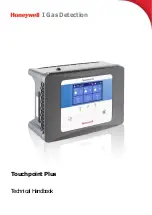
Electrical connections
7.3.
Temperature control
7.4.
Lowers / rises the temperature for at least 10 sec. under
/ over the min. / max. of the temperature boundary the
status LED for under- / over temperature will be acti-
vated. Additionally the status relay is de-energised. If
the max. temperature boundary is exceeded, also the
SSR heater circuit is galvanically disconnected. The
temperature boundary is +20 /-30 k from the adjusted
temperature set value.
During the heat up sequence under temperature is indi-
cated (LED/Relay) until the temperature set value minus
the low boundary of -30 k is reached.
For fault suppression during power on a delay of 0,5 sec.
is equipped.
Heater
7.5.
The heater control is done by the control electronic with
a solid state relay SSR with a series wired security relays
for safe galvanic isolation in fault condition. For SSR pro-
tection a lead fuse rated T 6,3 A is wired in series. hea-
ting pulses are displayed by the yellow heater LED.
Fault - alarm
7.6.
The status relays is operated in working principle and is
equipped with a volt free status contact (energised in
good condition). In case of alarm the security relays is
also de-energised.If a fault continues uninterrupted for
0 sec the alarm is visually displayed and signalled by the
status relay.
Short distortions will not be displayed and do not lead to
a fault condition. Failure indication is done by lighting up
the red LED. The fault code is signalized by short flas-
hing LED pulses between long flash pulses (refer to
table).
The controller locks in fault condition. A resuming of con-
trol operation is only possible by power reset (short in-
terruption of supply voltage).
Always operate contacts under specified ratings. For
connection of inductive and capacitive loads use suitable
protection circuits (e.g. recovery diodes for inductive and
serial resistance for capacitive loads). Relays are illus-
trated in current- less conditions (fail safe).
Manual JES-370
Elektrischer Anschluss
7.3.
Temperaturüberwachung
7.4.
Fällt / Steigt die Temperatur für 10 sec. unter / über die
min. / max. Temperaturgrenze ab, wird die Status LED
für Unter- / Übertemperatur aktiviert. Darüber hinaus fällt
das Statusrelais ab. Bei Übertemperatur wird zusätzlich
der heizungskreis des SSR galvanisch getrennt. Der
Temperaturwert ist +20 /-30 k vom eingestellten Solltem-
peraturwert.
Während der Aufheizphase wird Untertemperatur aus-
gegeben (LED/Relais) bis die eingestellte Solltemperatur
minus der Alarmtemperatur min. (-30 k) erreicht wurde.
Beim Anlegen der Versorgungsspannung läuft eine
kurze Einschaltverzögerungszeit von 0,5 sec. zur Stör-
unterdrückung ab.
Heizung
7.5.
Die heizungsregelung erfolgt über ein von der Regel-
elektronik gesteuertes Solid State Relais SSR mit einem
seriell geschalteten Relais zur sicheren galvanischen
Trennung im Fehlerfall. Zum Schutz des SSR ist eine
Schmelzsicherung T 6,3 A in Serie geschaltet. Die heiz-
impulse werden mit der gelben heizung LED angezeigt.
Störung - Alarm
7.6.
Das mit potentialfreiem Wechselkontakt ausgestattete
Statusrelais wird im Arbeitstromprinzip betrieben (d.h. im
Gut Zustand angezogen). Bei aktivem Alarm ist auch
das Sicherheitsrelais abgefallen. Nach 10 sec ununter-
brochenem Auftreten des Fehlerzustands wird der Alarm
visuell angezeigt und mit dem Statusrelais ausgegeben.
kürzere Unterbrechungen führen dabei zu keinen Ab-
schaltungen oder Signalisierungen. Die Fehlersignalisie-
rung wird durch Aufleuchten der roten Fehler LED
angezeigt; wobei jeweils durch lange Blinksignale ge-
trennt der Fehlercode mit kurzen Blinkimpulsen signali-
siert wird (siehe Tabelle).
Der Regler schaltet verriegelt ab. Eine Wiederaufnahme
des Regelbetriebs ist nur durch einen Netzreset möglich
(kurzzeitige Unterbrechung der Versorgungsspannung).
Die kontakte sind zu jeder Zeit innerhalb der spezifizier-
ten Werte zu betreiben. Induktive und kapazitive Lasten
sind mit entsprechenden Schutzmaßnahmen anzu-
schließen (z.B. Freilaufdioden bei induktiven Lasten und
Serienwiderstände bei kapazitiven Lasten) Relais sind
in stromlosen Zustand (Fail safe) dargestellt.
BA_DE_JES370_v1.3
––––––––––––––––––––––––––
[ 20 / 30 ]
––––––––––––––––––––––––––











































